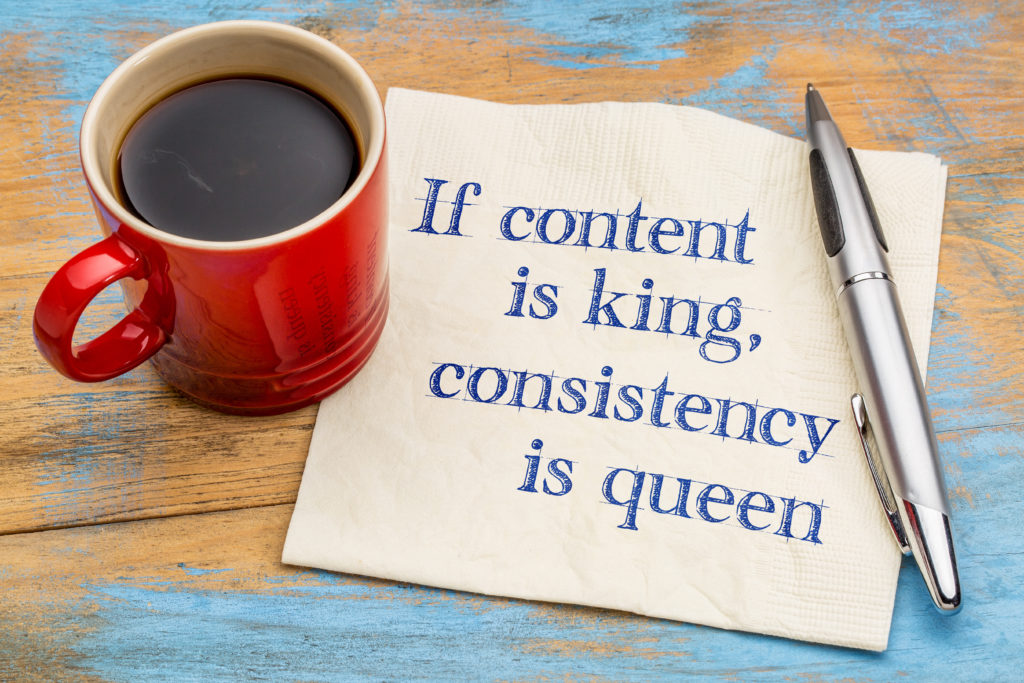Consistency within a course

The phrase “consistency is key” is so ingrained in a learning experience designer’s mind that it is always a shock when someone, usually of a different profession, desires otherwise.
When I began a new job, I was told that the higher ups wanted as much variety as possible in our eLearning courses, and that meant that every slide should look different from every other, and that as many different interactions as possible should be used. I was told that our learners get bored quickly and variety is required to keep them engaged.
I couldn’t convince them otherwise. Even my old trustworthy argument, “I’m designing in a way that works best for the content – each slide’s design depends on the actual content that will be put on it and how the learner will learn best” was met with stony silence.
As a new employee, I did exactly what was asked of me. But now, I wonder how I could have done a better job explaining the importance of consistency – or, was I just plain wrong?
A. From the realm of graphic design
Although I am by no means a graphic designer, I do know a few of the basic principles. The first things I ever learned about graphic design were the CRAP principles. Contrast-Repetition-Alignment-Proximity are good guidelines for a novice designer to follow.
Although it uses a different word, repetition gets at the concept of consistency. According to Robin Williams, you should “Repeat visual elements of the design throughout the piece…this develops the organization and strengthens unity” (Williams, 2015). In my mind, the visual elements described by Williams could refer to the assets on the slide, such as buttons, text boxes, pictures, etc., as well as interactive elements and animations. From a purely visual perspective, it seems that consistency is our friend.
B. From the realm of multimedia learning theory
It doesn’t matter how great the graphic design is, as we know, there is much more to learning than physical appearance. That is where multimedia learning theory comes in. It can tell us why developing organization and strengthening unity (as described by Williams) is so important.
Richard Mayer is the guru of multimedia learning design. One concept he writes of frequently is extraneous overload. This is a type of cognitive overload that occurs when the essential processing and the extraneous processing combined are greater than the learner’s cognitive capacity (Mayer, 2014). In plain words, this means that the learner’s brain is overwhelmed by the combination of brain power required to manage the content plus brain power required to look at unhelpful images, navigation, animations, etc.
Due to the limited capacity of the human brain, Mayer recommends following a number of multimedia principles designed to reduce extraneous overload. One of these principles is called the coherence principle. This principle states that people learn better when extra material (that which is not required for learning) is excluded rather than included.
Having a variety of irrelevant images, a large number of fonts and colours, confusing navigation, or flying, flipping, and twirling animations all add to the extraneous material that should be excluded. This means that a consistent look, with consistent navigation, and only the essential information aids in learning.
When the learner doesn’t need to think about where to look next, how to interpret the content on the slide, or how to move on to the next slide, then the coherence principle has been followed. From a multimedia learning theory perspective, it seems that consistency is the goal.
C. From the realm of cognitive theory
From both a visual perspective and a learning perspective, consistency is key. But how does consistency make us feel?
Apparently, the desire for predictability is an innate human characteristic. Humans act based on the consequence of previous actions. We expect that what happens once will happen again (Glaserfeld, 1997). We expect that the layouts, colour schemes, and navigation that we see in a course will be replicated throughout the course. This helps us understand how to interact with the course.
This point should be particularly interesting to constructivists. A major strategy of constructivism is to provide context to all that is taught. This works because learners expect that what happened in the past will repeat itself in the same way.
Conclusion
From graphic design to cognitive theory, research suggests that there should be internal consistency in a course. Once learners understand the navigation and know what to expect when they see certain layouts, the level of extraneous processing dips. But what about consistency from course-to-course? Is it just as important to keep the same format for different training topics? Check out the part 2 next week for more information.
References
Ferguson, D. (2015, April). Steering away from cognitive overload. Retrieved from https://www.td.org/insights/steering-away-from-cognitive-overload
Glaserfeld, v.-E. (1998). Anticipation in the constructivist theory of cognition. Woodbury, NY: American Institute of Physics.
Johnson, J. (2016, May). How CRAP will make you a better designer. Retrieved from https://creativemarket.com/blog/how-crap-will-make-you-a-better-designer
Mayer, R.E. (2014). The Cambridge handbook of multimedia learning (2nd ed). New York, NY: University of Cambridge.
Williams, R. (2015). The non-designer’s design book (4th ed.). PeachPit Press (Pearson Education): USA.